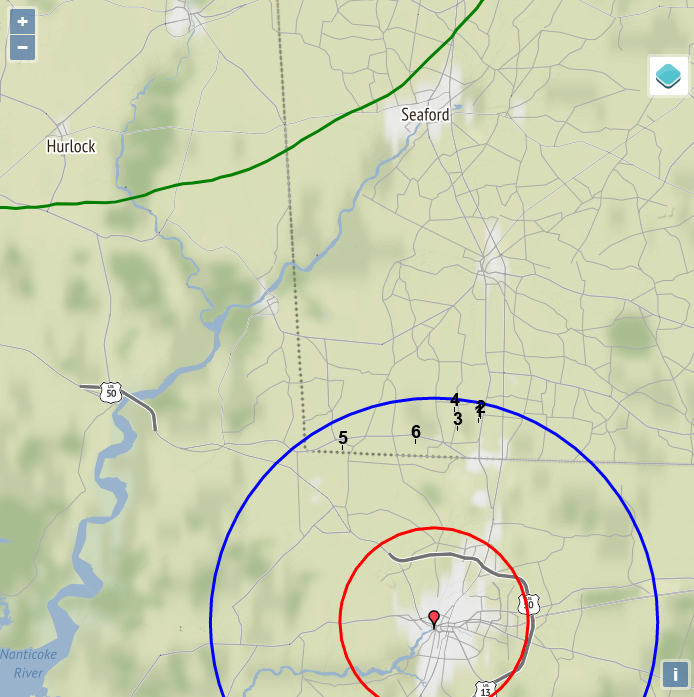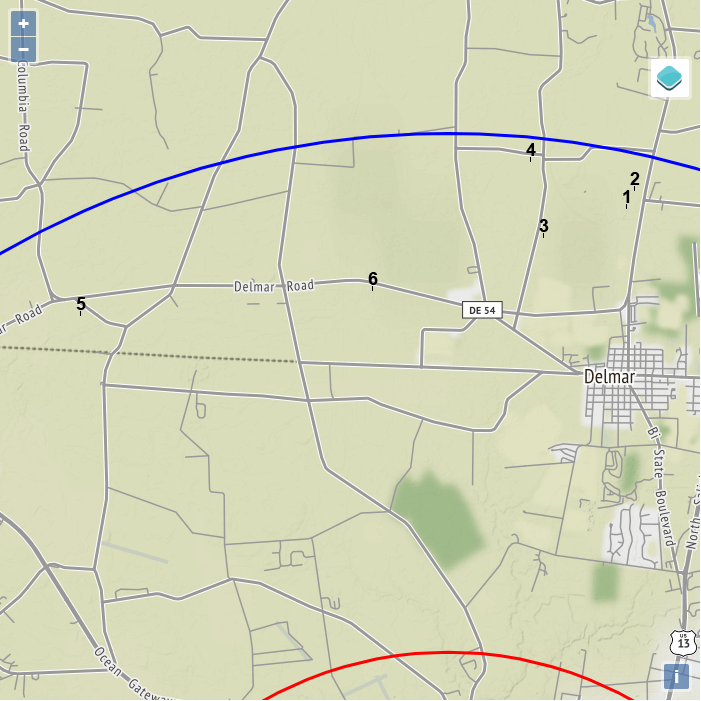myLPFM Help
Station Management
LPFM Channel Searching
Move station to a different location
Alternate channel at the same site
Reading Channel Search results
LPFM.us Station Directory
Miscellaneous Functions
Translator Interference
- Introduction
- Listener location
- Undesired to Desired (U/D) Ratio
- Translator Interference Check
- U/D study results
- Add complaint to Interference Package
- Interference Packages
- Interference Report
Introduction
FM translators are broadcast stations that simply rebroadcast the signal of other broadcast stations. Like LPFM, FM translators are secondary services, but most FM translators have technical facilities superior to that of LPFM stations.
There is also a disparity between how FM translators are assigned vs. LPFM stations. Where LPFM uses a method of simple distance separation, FM translators use a more precision method using contours. FM translators can take advantage of directional antennas to squeeze into certain locations and place their interfering contours right on the edge of other broadcast stations, including LPFM stations.
While the use of contours is considered an industry standard for protection, terrain and other factors still make these stations prone to causing interference to existing broadcast band users. To deal with this, the FCC has rules §§ 74.1203(a) and 74.1204(f). These rules allow an existing station (full-service, LPFM or other FM translator) to protest a new or modified FM translator based on predicted or actual interference to the incumbent station.
myLPFM's Translator Interference Check functionality allows LPFM stations to determine if a subsequent new or modified translator is predicted to cause interference under the FCC's interference remdiation guidelines. This is done by measuring the field strength contours of both the LPFM station (the desired signal) and the FM translator (the undesired signal) at the location of an LPFM station's listener.
To access myLPFM's translator interference functions, click on the
![]() triangle icon on the Left Menu.
triangle icon on the Left Menu.
Listener location
In order for any listener complaint to be valid, the actual or predicted interference must take place at a listener location that is located within the 45 dBu service contour of the LPFM station.
Undesired to Desired (U/D) Ratio
Undesired to Desired Ratio (U/D Ratio) is calculated by determining the both interfering contour of the translator (undesired) and the service contour of the LPFM station (desired) at the listener's location and then subtracting the desired field strength (LPFM) determination from the undesired field strength (translator) determination. Interference will be determined to happen if that calculation (the U/D Ratio) is greater than the following:
- Co-channel: -20
- First-adjacent: -6
- Second- and third-adjacent: +40 (see note)
NOTE: The area of interference in the case of second- and third-adjacent stations is extremely small. Based on that and REC's overall position on the impacts of 'interference' from second- and third-adjacent channel stations, myLPFM only supports interference checks for co-channel and first-adjacent channel relationships.
Translator Interference Check
Feature avaialble for all myLPFM users.
§§ 74.1203(a) and 74.1204(f) specify the number of valid interference complaints that a complaining station must have before they can make a complaint with the FCC. The number of complaints is based on the complaining station's 60 dBu service contour population. myLPFM will check census block data in order to determine the population served by an LPFM station and then applying the FCC's rules, determine the minimum number of valid listner complaints that must exist before the issue can be escalated.
The myLPFM Translator Interference Check will look for FM translator applications and authorizations in a particular distance on co-channel and first-adjacent channels and display them in one of two sections.
In the first section, it will display FM translators that may have been applied for since the LPFM station was last licensed as these applications or authorizations may be subject to interference remediation. Note that for LPFM stations, this means that the clock resets the last time the station was granted a license to cover or modification of license. For example, an LPFM station is originally granted at location A and then three years later, files a modification to move to location B. As soon as the LPFM station operates from Location B, the clock is reset and any application by the FM translator is no longer considered subsequently filed. Therefore, even though the LPFM could have protested a subsequently applied for translator while they were at Location A, they can't protest after the LPFM is moved to Location B. Even if the LPFM station does not change locations on a construction permit (such as a modification of the antenna height or a change in channel), the clock will still restart since those translators would no longer be subject to the redress policies.
In the second section, it will display FM translators that may have been applied for prior to when the LPFM station performed its last licensing action. In most of these cases the LPFM station may not be able to seek redress.
NOTE: In cases where a modification of license was done solely to change the antenna and or feedline type and modify transmitter power output only or to modify a time share schedule where in both cases, the station's location, channel and antenna radiation center height are not changed, it may be possible to seek redress. However, at this time, myLPFM does not distinguish modification of license applications for these specific purposes. While myLPFM will still perform interference checks in these situations, REC Client users will be unable to build interference packages involving these translators.
Then, the listener's address must be entered. As you start typing the address, the system will suggest possible addresses. Click on the one that is correct and then click on [Check U/D Ratio for this location].
NOTE: If you do not select the address from the drop down, then the system will not accept the entry and you will receive an error when you click the [Check U/D Ratio at this location] button.
U/D study results
Feature avaialble for all myLPFM users.
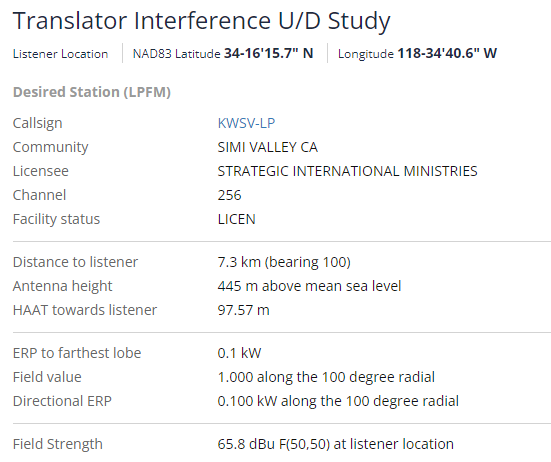
myLPFM will return the results of the U/D study for both the desired (LPFM) and undesired (translator) stations.
The data for each station includes:
- Callsign - The station's call sign
- Community - The community of license
- Licensee - The licensee or applicant's name
- Facility Status -
- Distance to Listener - Distance from the station to the listener as well as the bearing (direction) from the station to the listener.
- Antenna Height - Antenna height in respect to sea level
- HAAT towards listener - Height Above Average Terrain from station in the direction of the listener
- ERP to farthest lobe - The overall effective radiated power (ERP) of the station
- Field value - The field value of a directional antenna in the direction of the listener. (non-directional antennas will show 1.000)
- Directional ERP - The reduced ERP in the directional antenna towards the listener. Reduction is based on the field value.
- Field Strength - Arriving field strength contour at listener location. (Service contour for desired station, interfering contour for undesired station.
| LICEN | Licensed station |
| LICSL | Licensed station that is currently silent |
| CPOFF | Original construction permit granted |
| CPAPP | Original construction permit not yet granted |
After the analyses on both stations, the Overall Analysis section will show:
- Channel relationship - Whether the translator is on the same channel (co-channel) or a first-adjacent channel
- U/D Ratio required - The minimum U/D ratio required for an interference complaint
- U/D Ratio at listener - The U/D ratio calculation for this listener
- Valid complaint - A Yes/No answer to whether the complaint meets the guidelines. If not, the reason is shown why not
If you want to check a different address, click on the [Check another address] button.
Add complaint to Interference Package
Feature avaialble for REC Clients with a $350 minimum spend.
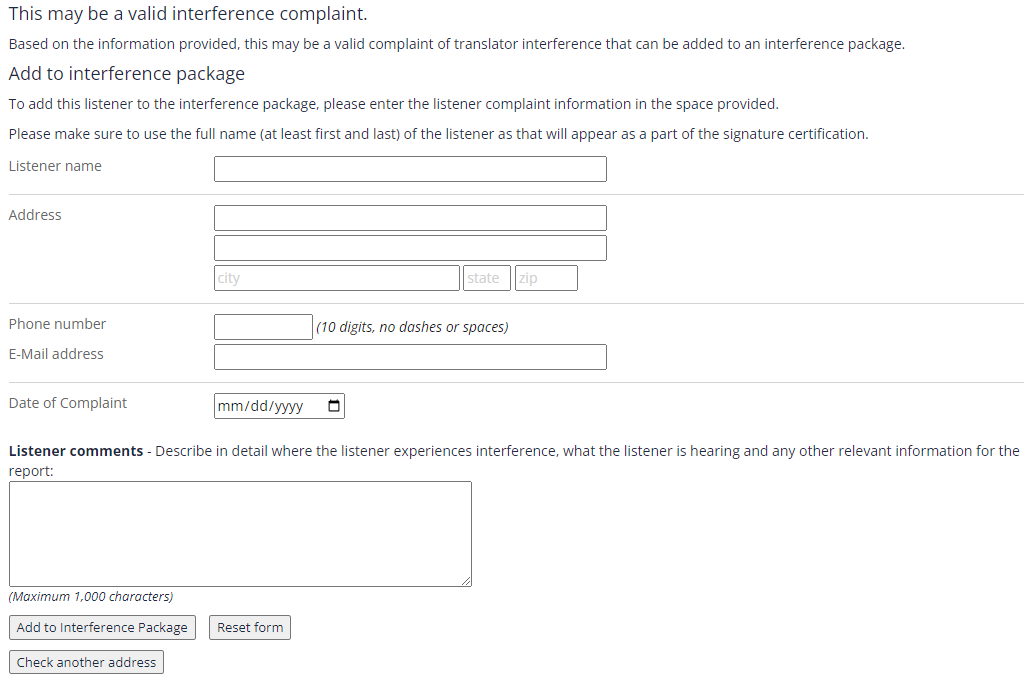
If the complaint is valid and is for a subsequently requested translator facility, REC Clients can add the listener complaint into the interference package. Listeners should be advised that all of the information entered for this form will become public record as a part of the interference package.
In the listener comments section, include a statement of where the listener is located at the time of the interference and what they are hearing if the translator is already on the air.
Once completed, click on [Add to Interference Package] to include the complaint to the interference package.
Interference Packages
Feature avaialble for REC Clients with a $350 minimum spend.
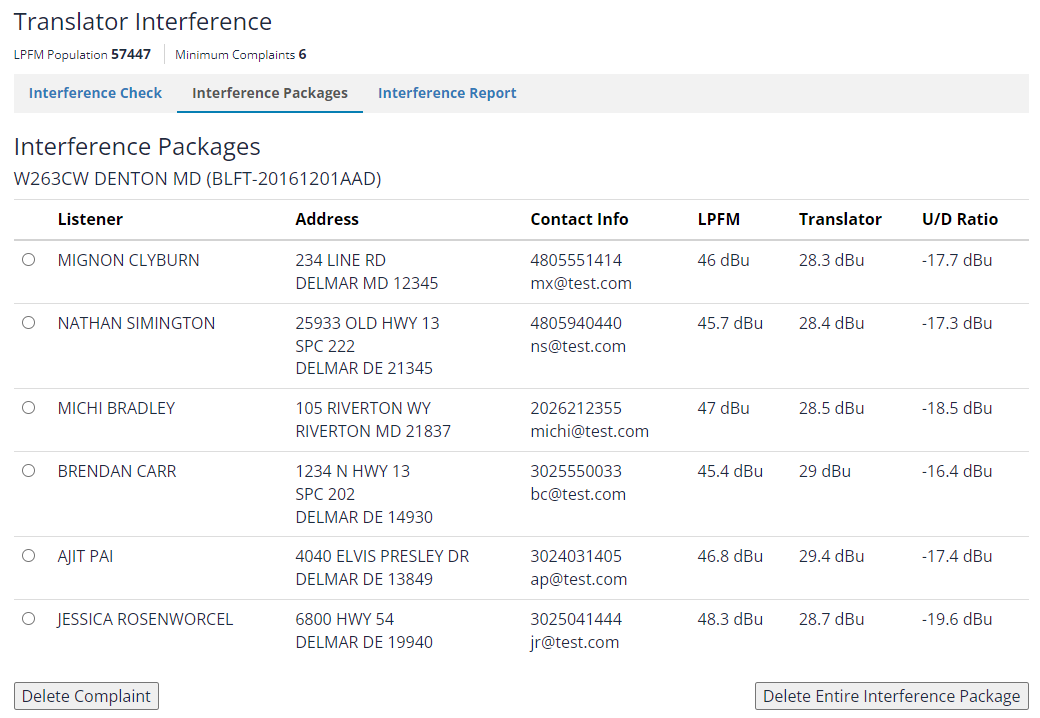
By clicking on the Interference Packages tab, the saved listener complaints will be shown.
To delete one of the complaints from the package, click the radio button to the left of the name and then click [Delete Complaint].
To delete the entire interference package (all listener complaints), click on [Delete Entire Interference Package]
If an LPFM station has multiple interference packages active, then each package will be in its own section with its own delete buttons.
NOTE: Once you delete a listener complaint or an entire package, it is permanently deleted and can't be recovered. REC will be unable to recover deleted complaints or packages, so please be careful using these buttons.
Interference Report
Feature avaialble for REC Clients with a $350 minimum spend.
Preparing the report
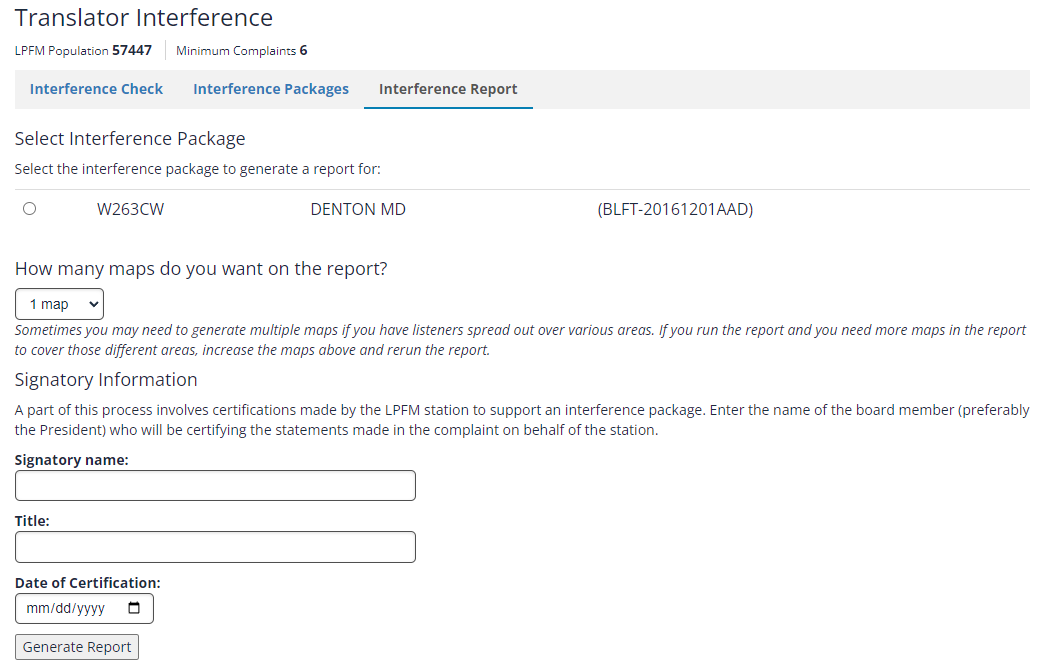
Once you have enough valid interference complaints in the package, you can click on the Interference Report tab. On this tab, select the button to the left of the Interference Package that you want to generate.
You can select up to 9 maps to be used in the report. All maps are the same interactive maps and each can be changed to zoom in on a particular area. We suggest that you start with one map. If you have valid listner complaints over a wider area, then you should run the report again with additional maps.
In the signatory section, enter the name and the title of the board member who is certifying this Interference Package on behalf of the LPFM station. The date of this certification must also be entered.
To generate the report, click on [Generate Report].
NOTE: It is highly recommended that you use a desktop or laptop commputer as opposed to a mobile device for preparing the Interference Package exhibit.
The Interference Package exhibit
When [Generate Report] is clicked, a new window will open. The system may hesitate for a little bit as myLPFM is going out to the FCC's Contour system in order to obtain various contours for the LPFM and the FM translator.
Before doing anything, scroll down to the map to make sure that you can see three contours (red, blue and green). If all three contours do not appear, you may need to either click the refresh button on your browser or re-run the report from myLPFM. Also, if you do not see the green contour, you may need to zoom out on the map. Click the minus [-] button on the upper left portion of the map to zoom it out.
On the map, use the [+] and [-] buttons on the upper left portion of the map to zoom in and out. The locations of the listeners will be in black numbers. The map should be formatted in a way where the red and blue contours partially show on the map and that the listener ID numbers show without any overlap in the numbers. If you cannot zoom that close and keep all listeners on one map, then rerun the report with additional maps. Each map is a duplicate of the other but can be individually manipulated to show other areas.
PRO TIP: Run the first report with at least two maps. Make the first map be an overall map showing the contours involved, even if the listner ID numbers overlap:
Then use the additional map(s) to provide closeups on the areas where listeners are:
Other than the maps, nothing else needs to be done with this exhibit. You may use your browser's print option to print the document. The document will be formatted to provide page breaks at the proper location. If your computer has the ability to save a print as a PDF file, then select 'Print as PDF' and then it will also you to save a file name. Put any file name you want in there.
Before filing an Interference Package with the FCC
Make sure that all of your listener complaints are from disinterested people. This means, no family members, no boy/girl-friends, no volunteers or their families, no underwriters or their families, etc. The only thing the listener would be able to gain is the ability to hear their favorite station better and no more than that!
The FCC Rules require that before submitting an Interference Package, that the complaining station must use commercially reasonable efforts to inform the relevant translator licensee and to attempt private resolution. In other words, reach out to the translator licensee and try to work out the interference issues first. Document everything. If you reach an impasse in those negotiations (if any negotiations even start), then you can proceed to the FCC Interference Package process.
